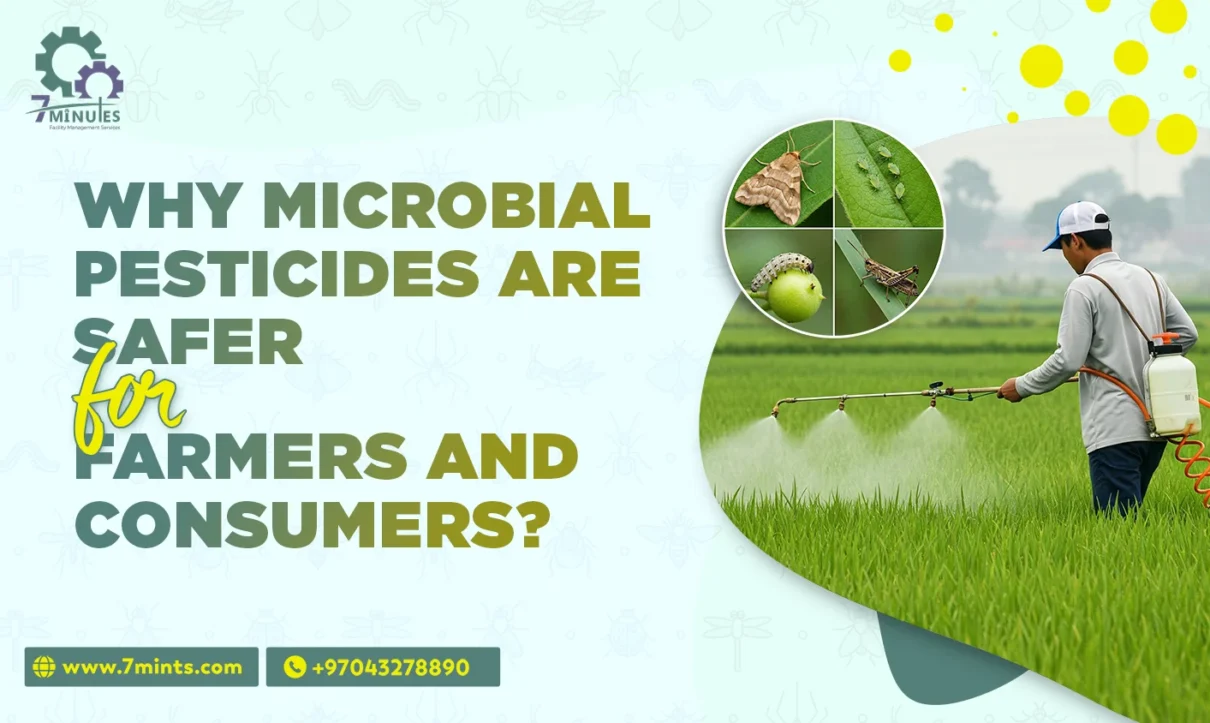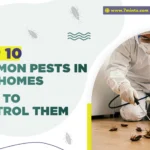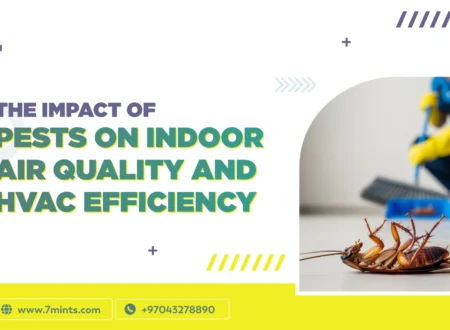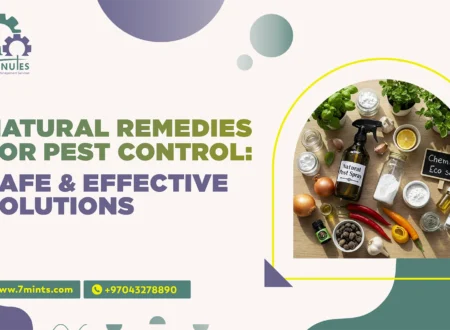Microbial pesticides are gaining prominence as biopesticides for safer alternatives to traditional chemical pesticides. Microbial pesticides are obtained from naturally or genetically modified microorganisms like fungi, bacteria, viruses, and especially protozoa. By providing several benefits from the perspective of farmers, consumers, and the environment, this blog discusses how microbial pesticides are safer and for sustainable agriculture.
What Are Microbial Pesticides?
Microbial pesticides consist of living or killed microorganisms as active ingredients for controlling diseases or pests. These products target some specific pests via an infection mechanism, toxin production, or even competition for resources. Unlike synthetic pesticides that often affect a broad range of organisms, microbial pesticides are very specific, thus minimizing non-target effects and reducing environmental toxicity.
For instance, Bacillus thuringiensis (Bt), a bacterium used in microbial pesticides, has already been well known for the production of proteins that are toxic for some specific larvae of insects. Following ingestion, those proteins disrupt the digestive system of insects leading to their death. This targeted action would make sure that beneficial insects like bees and butterflies would not be affected, thus preserving biodiversity in agricultural ecosystems.
Microbial Pesticides Work in the Following Way:
Microbial pesticides work by both direct and indirect mechanisms against pests:
Direct Mechanisms:
Infection: The pathogenic fungus or bacteria infects a pest through ingestion or penetration, causing paralysis or death. For example, Beauveria bassiana infects the insect because it penetrates the exoskeleton to cause a fatal infection.
Toxin Production: Microorganisms release toxins to kill or hinder pests. The Bacillus thuringiensis bacterium is well known for producing toxins that are fatal to some insect larvae.
Parasitism: Some microorganisms directly feed on pathogens, inhibiting growth—for instance, the form of nematodes that parasitize insect larvae.
Indirect Mechanisms:
Competition: Competing with pathogens by microbes for nutrients and space has been effective in eliminating them. Such competition may promote healthy plants and lower disease incidence.
Induced Resistance: Certain microbes are known to boost plant immunity, enabling the crop to resist infection from diseases. For example, certain bacteria induce systemic acquired resistance in plants, making them more resilient to pathogens.
These targeted modes of action make microbial pesticides highly effective against specific pests while sparing beneficial organisms such as pollinators.
Advantages of Microbial Pesticides
1. Low Toxicity
Microbial pesticides are inherently less poisonous than chemical counterparts and affect primarily the target pest and non-target organisms like birds, mammals, and beneficial insects (e.g., honeybees). For example, Bacillus thuringiensis has a general recognition of safety (GRAS) under human consumption and minimal risk to wildlife.
Reduced toxicity means that the farmer’s visit to treated fields can be hastened, resulting in reduced downtime and increased productivity. This factor is indispensable for smallholder farmers whose livelihoods depend on prompt returns from crop harvests.
2. Environmental Safety
Unlike their synthetic counterparts, microbial pesticides leave harmful residual residues in soils and waters after application decomposition. Their natural origin prevents long-term contamination of ecosystems and keeps biodiversity and soil healthy. This is very important for maintaining healthy ecosystems, as residues build up in food chains, which in turn harm wildlife.
Take, for instance, fungal pathogens caused by Trichoderma harzianum, which controls certain fungal diseases in crops without any toxic residues. This fungus helps grow plants while increasing soil fertility, thus contributing to sustainable agricultural practices.
3. Target Specificity
The specificity of microbial pesticides ensures less influence on non-target species. While broad-spectrum chemical pesticides will kill diverse organisms altogether in the ecosystem, target-specific pesticides will only have the intended effect. Target specificity also reduces the likelihood of developing resistant pest populations against the pesticide, as the pesticide would have only affected the intended pest.
This quality increases the use of microbial pest control agents to have effects in IPM strategies during which healthy ecological balance is very important. Coverage of all other aspects of healthy ecosystem mechanisms in controlling pests is attainable through purposeful use of microbial pesticides.
4. Development of Resistance Reduced
Due to this common, almost unvaried activity, chemicals tend to develop pest resistance. Microbial pesticides in most cases have very intricate mechanisms of action that make it so improbable for a pest to develop resistance against them; probably it might be so systemic in terms of different sites targeted within the pest organism’s biology.
Thus, they include multiple toxins for Bacillus thuringiensis targeting different parts of the insect digestive system. The multi-targeted approach thus reduces the opportunity of developing resistance in comparison to one-site chemical pesticides.
5. Compatibility with Integrated Pest Management (IPM)
Microbial pesticides can readily integrate into IPM programs with other biological controls and synthetic products. IPM strategies involve many control strategies for sustainable pest population management.
Microbial pesticides therefore sustain the IPM strategy that gives farmers leeway to reduce the use of chemicals, prevent environmental pollution, and allow the ecosystem services of beneficial organisms. This approach thus contributes to agricultural sustainability and resilience in the most holistic way possible.
6. Worker Safety
Farmers handling microbial pesticides incur fewer health hazards than when using any chemical. Most of the microbial products exhibit low re-entry intervals (REI), and pre-harvest intervals (PHI), and very safe application practices. This means the farmer will not spend much time after treatment waiting to re-enter the fields with agricultural work.
Also, the lower toxicity of microbial pesticides greatly reduces the risks of accidental exposure, resulting in an overall safe working environment for agricultural workers. This is especially beneficial where accessing protective equipment can be hard.
Impact on Sustainable Agriculture
Microbial pesticides promote sustainable agriculture by:
Protecting Biodiversity: Their selective activities primarily protect the beneficial organisms for the maintenance of ecological balance for the long-term sustenance of agricultural ecosystems.
Soil Health: Rapid decomposition prevents soil degradation, restoring fertility and structure. These create avenues for sustainable crop growth and reduce reliance on synthetic fertilizers.
Food Security: By contributing to reduced chemical pesticide use, the microbial product will maintain crop yields while ensuring ecological balance.
Further, microbial pesticides promote climate resilience through soil carbon sequestration and mitigate greenhouse gas emissions from chemical pesticides’ production. Hence, this is a very promising course of action toward climate change mitigation with food security assurances.
Challenges in Utilizing Microbial Pesticides
Although very effective, microbial pesticides nevertheless have their own limitations:
1. Environmental Sensitivity
These live microbes require specific environmental conditions in order to thrive. Their starvation conditions under sunlight or inappropriate temperatures and inferior examples of microbial formulations that decompose quickly under ultraviolet light necessitate administration during cooler parts of the day.
2. High Specificity.
In this situation, farmers would have to use a number of microbial formulations for addressing various pest problems, which are not only expensive but also logistically hard to deal with in comparison to broad-spectrum chemical pesticides.
Moreover, the specificity of microbial pesticides allows for more accurate pest management strategies, thereby reducing unnecessary dependence on chemicals while maintaining beneficial organisms, as most IPM principles teach target-specific control methods.
3. Variable Efficacy
The environmental conditions, such as humidity and temperature, can affect the efficacy of microbial products. Compared to chemical ones, this renders their efficacy less predictable.
Farmers may optimize their application timing by using weather forecasting and tracking tools to ensure the provision of conducive conditions for microbial efficacy.
4. Shelf Life Limits
Besides, a lot of microbial formulations have a much shorter shelf life than synthetic products, which poses logistical challenges in their storage and distribution. Thus, careful management of inventory and timely applications are necessary to ensure product viability.
Manufacturers are working towards longer shelf lives by developing stable formulations and packaging systems, some involving desiccants or refrigeration in maintaining microbial viability during storage.
5. Lack of Awareness
Limited access to educational resource materials and training programs may not fully empower farmers in the use of microbial pesticides. Raising awareness is critical for their wider adoption.
Examples include the CABI BioProtection Portal that provides online, free access to information on biopesticides and sustainable pest control practices for farmers. These initiatives would help reach that area of knowledge and enhance the integration of microbial pesticides into mainstream agriculture.
Future Perspectives
Microbial pesticides have their drawbacks, which are being solved by technological improvements.
Awareness Programs: CABI BioProtection Portal is an example of an open platform through which farmers can access information on biopesticides and sustainable pest control techniques. Such knowledge helps farmers incorporate microbial pesticides into their systems effectively.
Farm Systems Integration: More and more microbial pesticides are being accepted for use as an internal stakeholder for sustainable farming practices worldwide owing to the growing state of awareness. Then, this bio-pest control shift gets held for different fora the world over, projecting a reduction of chemicals and eco-friendly farming methodologies.
Advances in engineering are making it possible to develop more efficient strains of microbes. Genetically modified strains of Bacillus thuringiensis, for instance, can produce toxins having a wider range of potency against various target pests, thereby improving their efficacy within other agricultural environments. check out the latest blog post on Top 10 Common Pests in UAE Homes and How to Control Them
Microbial Pesticides Emphasised for Farmers
For those wanting less hazardous chemical alternatives for pest control, microbial pesticides excel:
Worker Safety: Exposure of workers to toxic chemicals is limited. This is an important issue for small-scale farmers because they themselves usually spray the pesticides.
Compatible with IPM Programs: It fits into IPM programs by enhancing all effective pest management practices for the sustainable management of pests while minimizing damages to the environment.
Future-Proofing Agriculture: Microbial pesticides will guarantee the health of soil and biodiversity from the present generations into the future, thereby making agriculture sustainable in the long run. In other words, these farming techniques would be relevant for future generations too.
Adding to this would be the improvement in the quality of the produce, with diminishing chemical residues. Since consumers increasingly demand safer and, most importantly, sustainable products, it has become a dependable market for crops produced under methods of microbial pest control.
Why do Microbial Pesticides Work for the Consumers?
Microbial pest control methods will also benefit consumers.
Minimum Chemical Residue: Microbial pesticides leave almost no residue on food. Therefore, they are safer to eat from this angle. There has been so much talk about the long-term health effects of exposure to harmful chemicals. It is good if this risk could be minimized.
Environmental Benefits: How green is a particular farm practice that fits with consumer tastes for sustainability? Consumers are less likely to purchase items produced from farming practices that damage the surrounding ecosystem.
Microbial pesticides support food security by maintaining agricultural systems. Food security ensures that nutritious food is provided sustainably while maintaining ecosystem balance.
Additionally, these microbial pesticide functions would provide an avenue for strengthening local economies toward sustainable farm use. This will cement farming systems to greater resilience suited to contend with challenges as stark as environmental threats and market volatility.
Conclusion
These microbial pesticides are an inspiring milestone in the advancement of agriculture toward safety and sustainability. Less toxic and much more environment-friendly, these pesticides act by targeting only specific insects; they also blend well with IPM programs, thus Contact us as augmenting modern agricultural practices. Whereas challenges concerning efficacy and awareness still remain, an advancement through research and education is on the path of large-scale adoption.
Microbial pesticides have enabled farmers to protect themselves, their crops, and the environment while guaranteeing that both they and consumers benefit from safer agricultural practices. The gradual transition to sustainable food systems, with microbial pesticides as an essential input, is the future of agriculture.










1 Comment
Comments are closed.